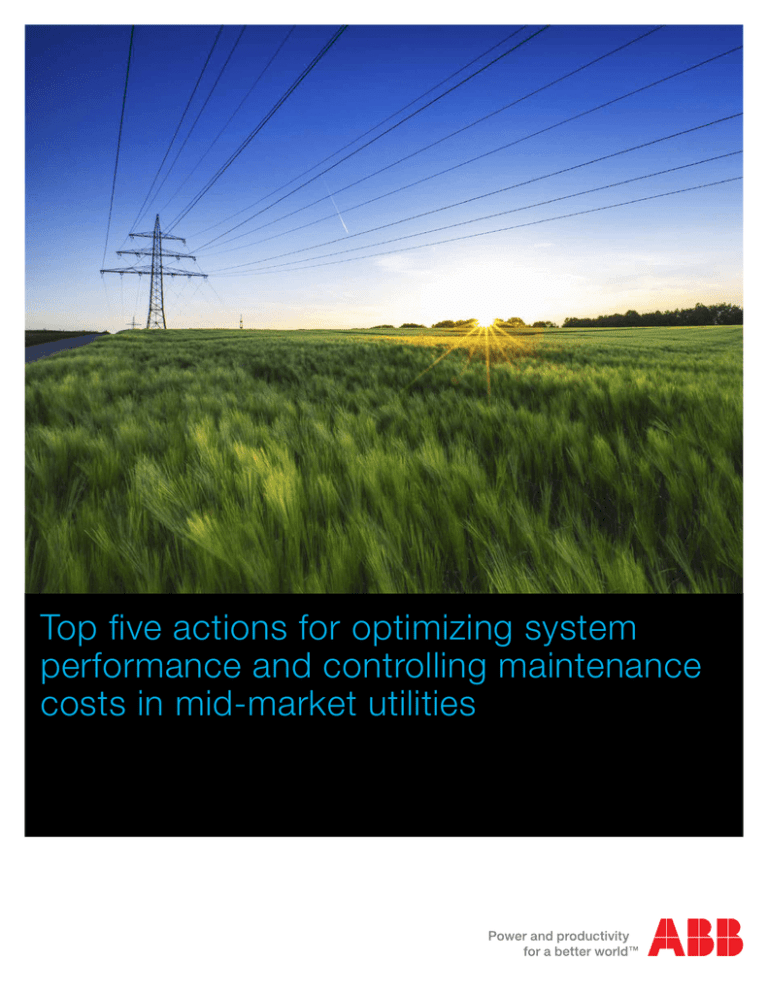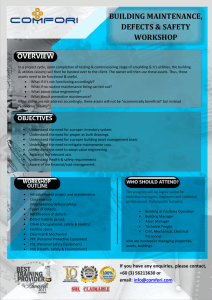
Top five actions for optimizing system
performance and controlling maintenance
costs in mid-market utilities
To improve asset availability and performance, you must manage
assets based on risk and criticality to operations, and systematically
prioritize maintenance work.
Although mid-market utilities – whether electric, natural
gas, water or wastewater – are very different, they share
many commonalities.
First, all rely heavily upon their infrastructure and assets as
a core component of operations. In fact, these assets are
so critical that if not operating properly, everything from
distribution to customer satisfaction can suffer.
So what does all this mean for mid-market utilities?
Thanks to recent advances in technology, all the benefits
that the “big” utilities have gotten from EAM solutions are
now accessible for the mid-market budget.
With a world-class EAM system, mid-market utilities can
be just five actions away from optimizing performance
and profitability:
Second, profitability is dependent upon maximizing the
performance and efficiency of company assets at every stage
of the lifecycle. So, maintenance of aging assets is key.
1. Manage assets based on operational criticality
Third, asset-intensive companies intrinsically require large
capital expenditures, thus financial performance reflects
the return on these investments.
4. Drive safety assurance at the point of potential incidents
Finally, the assets are typically spread across a wide
geographic area and subject to physical and environmental
stress. Therefore, providing a remote workforce with mobile
access to asset operations systems is necessary in order
to optimize performance.
To improve asset availability and performance, you must
manage assets based on risk and criticality to operations, and
systematically prioritize maintenance work. When assets are
ranked this way, maintenance becomes a strategic component
of proactive asset management.
For mid-market utilities, the sensitivities
and balance between maximum
performance and cost control make
staying ahead of system issues – both
operational and mechanical – even more
critical to delivering sustainable gains in
performance and profit.
In this day and age, it is not uncommon for maintenance
organizations to have more work to do than they can handle.
Implementing a risk and criticality assessment of assets not
only places priority on critical assets, but also identifies the
most critical parts within those assets.
Enterprise asset management (EAM) solutions help utilities
manage the asset lifecycle, and implement policies and
procedures to optimize asset utilization while minimizing costs.
However, until recently, comprehensive, “super-powered” EAM
systems were only financially feasible for large utilities.
2. Optimize your MRO supply chain
3. Enable decision making at the point of performance
5. Standardize on ISO 55000/01/02
1
Manage assets based on operational criticality
Implementing reliability-centered
maintenance, preventative maintenance,
and predictive maintenance programs
can further increase asset availability
and performance by ensuring that
the work most critical to operations is
completed first.
An EAM system purpose-built for asset-intensive industries
enables complete visibility and management of assets
enterprise wide. Further, it helps utilities apply maintenance
policies and strategies that maximize asset value, including
proactive programs such as condition monitoring and
reliability-centered maintenance.
2
Optimize your MRO supply chain
It’s imperative to take the guesswork out of the maintenance,
repair and operations (MRO) supply chain. Start by analyzing
why you stock certain parts in the first place – accurately
assessing the criticality of parts and adjusting stock levels
accordingly can free valuable capital. Additionally, having easy
digital access to parts manuals at the point of maintenance via
2 | Top five actions for optimizing system performance and controlling maintenance costs in mid-market utilities
Requiring field workers to pass a context-sensitive personal risk
assessment before they receive a work task can ensure they are well
prepared for the task.
mobile devices expedites parts identification, ordering, and
maintenance processes.
It’s also important to remember that the supply chain extends
beyond your own operation. Monitor vendor performance with
vendor score carding, lead-time metrics, and vendor
performance history. You can’t control your vendors, but you
can decide which vendors you do business with and how best
to work with them to ensure you have the supplies you need
when you need them.
3
Enable decision making at the point of maintenance
Field maintenance productivity often suffers from its own set
of challenges:
−− Lack of real-time management visibility
−− Insufficient automation tools for workers
−− No real-time planning and tracking
Mobile field workforce solutions provide real-time visibility into
what workers are doing, and drive collaboration and effective
operational decision making. This includes enabling a
productive flow of timely, accurate information to and from
the field, more effective service planning and scheduling,
and streamlined field operations.
Mobile applications enable workers to identify any potential
issues, and begin the work planning process where the asset
resides. This means specific parts or tooling required to rectify
an issue can be identified up front, minimizing wasted trips to
perform maintenance with the wrong part or equipment
4
Drive safety assurance at the point of
potential incidents
Remote operations, although critical, can intrinsically magnify
new and existing challenges. Field worker safety is a prime
example – what can you do to protect workers once they’re
out in the field?
Requiring field workers to pass a context-sensitive personal
risk assessment before they receive a work task can ensure
they are well prepared for the task. In the case of a utility
worker performing maintenance at a substation, part of the
personal risk assessment could be to ensure that all isolations
have occurred before receiving the actual task. Other
strategies include providing information that ensures that
assets are available and safe for maintenance work, and
providing monitoring credentials.
5
Standardize on ISO 55000/01/02
The International Organization for Standardization’s ISO
55000/01/02 is a framework for best practice asset
management for all types of physical assets across their
lifecycle. Standardizing on ISO 55000/01/02 can help you
make clearer connections between strategic organizational
plans and the day-to-day realities of asset and work
management.
An EAM system can make it easier for utilities to more readily
embrace ISO 55000/01/02 mandates by:
−− Managing risk before it becomes a problem
including building risk assessment and management into
alarms, inspections and defects, and work requests and
work orders.
−− Understanding the condition of every asset
including automatically calculating the current condition
of each asset based on inspection data.
−− Standardizing the Asset Registry business process
including registering assets according to ISO 55000/01/02
guidelines while ensuring that asset registers avoid
becoming too complex.
ABB’s EAM/ERP solution for the mid-market
Think only the largest of utilities can enjoy the benefits of
a full-featured EAM/ERP system? Think again: ABB has
launched Ellipse Select, a world-class EAM/ERP system
designed specifically for mid-market utilities.
Like our flagship Ellipse EAM/ERP system, Ellipse Select
provides complete enterprise-wide visibility and
management of assets. In contrast to the highly
customizable Ellipse, Ellipse Select has been preconfigured
with the industry-specific logic, workflow, and best
practices that the large utilities have benefited from for
35+ years. This allows for a rapid implementation and
streamlines ongoing administration. In fact, Ellipse Select
can be operational in as little as 90 days. And because
it can be hosted in the cloud, powered by Microsoft Azure,
or on site with Microsoft SQL Server, it can help to reduce
hardware overhead as well.
To learn more about Ellipse Select and how it can help
you optimize performance and maintenance costs
containment, go online or contact us today!
These practices work best when streamlined by putting
information and best-practice safety processes in the hands
of on-site maintenance workers through mobile technologies.
Doing so protects workers, assets, and margins.
Top five actions for optimizing system performance and controlling maintenance costs in mid-market utilities | 3
About us
About the Enterprise Software product group within ABB
We provide industry leading software and deep domain
expertise to help the world’s most asset-intensive industries
such as energy, utilities and mining solve their biggest
challenges, from plant level, to regional network scale,
to global fleet-wide operations.
For more information please contact:
Enterprise Software
Americas:
+1 678 825 1458
+1 800 868 0497 from US and Canada
Our enterprise software portfolio offers an unparalleled range
of solutions for asset performance management, operations
and workforce management, network control and energy
portfolio management to help customers reach new levels
of efficiency, reliability, safety and sustainability. We are
constantly researching and incorporating the latest
technology innovations in areas such as mobility, analytics
and cloud computing.
Europe, Middle East, Africa:
+44 1483 794080
We provide unmatched capabilities to integrate information
technologies (IT) and operational technologies (OT) to provide
complete solutions to our customers’ business problems.
Asia Pacific:
+61 7 3303 3333
www.abb.com/enterprise-software
info.pges@abb.com
Note
The information contained in this document is for general information
purposes only. While ABB strives to keep the information up to date and
correct, it makes no representations or warranties of any kind, express
or implied, about the completeness, accuracy, reliability, suitability or
availability with respect to the information, products, services, or related
graphics contained in the document for any purpose. Any reliance
placed on such information is therefore strictly at your own risk. ABB
reserves the right to discontinue any product or service at any time.
© Copyright 2016 ABB. All rights reserved.


